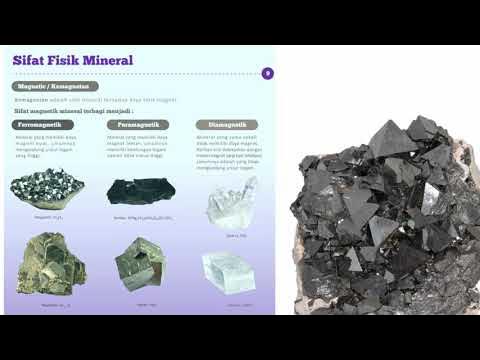Mineralogi Optik - Video Penjelasan Praktikum Acara VIII: Amfibol, Piroksen, Mika
Summary
TLDRThis presentation focuses on the optical properties of amphibole, pyroxene, and mica minerals, explaining their classification, structure, and distinctive features. It covers the pleochroism of amphibole, the crystalline structures of pyroxene, and the layering characteristics of mica. Each mineral's optical behavior under polarized light is discussed, highlighting variations in color, relief, and cleavage angles. The session emphasizes the importance of these properties for mineral identification and interpretation, providing examples and visual demonstrations to enhance understanding. Participants are encouraged to ask questions for further clarification.
Takeaways
- 😀 Amphibole is a group of minerals characterized by double chain silicates and typically exhibits a monoclinic crystal structure.
- 😀 Key minerals in the amphibole group include tremolite, actinolite, glaucophane, and hornblende.
- 😀 Amphiboles show strong pleochroism, meaning their color changes significantly when viewed from different angles.
- 😀 Piroxenes, unlike amphiboles, are single chain silicates and can be classified into orthopyroxenes and clinopyroxenes based on their crystal structure.
- 😀 Common minerals in the pyroxene group include enstatite, hypersthene, and diopside, which have distinct optical properties.
- 😀 Pyroxenes typically exhibit weak pleochroism and have a characteristic two-directional cleavage at approximately 90 degrees.
- 😀 Mica is classified as a phyllosilicate and can be identified by its sheet-like structure and one-directional cleavage.
- 😀 Variability in color and optical properties in micas, such as muscovite and biotite, is influenced by their chemical composition.
- 😀 Mica minerals display strong interference colors and can be identified by the presence of 'bird's-eye' structures during observation.
- 😀 Differentiating between amphibole, pyroxene, and mica involves examining their cleavage angles, crystal habits, and associated mineral formations.
Q & A
What is the main focus of the eighth session in optical mineralogy?
-The session focuses on studying the optical properties of amphibole, pyroxene, and mica.
How are amphiboles classified in terms of their mineral structure?
-Amphiboles are classified as inosilicates with a double chain structure.
What characteristic optical property is notable in amphiboles?
-Amphiboles exhibit strong pleochroism, which means their color changes when viewed from different angles.
What are some common minerals found in the amphibole group?
-Common minerals in the amphibole group include tremolite, actinolite, and hornblende.
What is a key difference in the crystal structure between amphibole and pyroxene?
-Amphiboles have a double chain structure, while pyroxenes are characterized by a single chain structure.
What are the two main crystal systems found in pyroxenes?
-The two main crystal systems in pyroxenes are orthorhombic and monoclinic.
How can one distinguish between orthopyroxene and clinopyroxene?
-Orthopyroxene has a parallel arrangement of its octahedral chains, while clinopyroxene has a tilted arrangement.
What is a distinctive optical feature of mica minerals?
-Mica minerals typically display perfect cleavage in one direction, allowing them to be easily split into thin sheets.
What are some examples of minerals in the mica group?
-Examples of mica minerals include muscovite and biotite.
How do the optical properties of amphibole, pyroxene, and mica differ in terms of color and relief?
-Amphiboles often show varied colors and high relief, pyroxenes usually have weaker colors and relief, while mica exhibits distinctive color variations and strong relief due to its sheet-like structure.
Outlines

Dieser Bereich ist nur für Premium-Benutzer verfügbar. Bitte führen Sie ein Upgrade durch, um auf diesen Abschnitt zuzugreifen.
Upgrade durchführenMindmap

Dieser Bereich ist nur für Premium-Benutzer verfügbar. Bitte führen Sie ein Upgrade durch, um auf diesen Abschnitt zuzugreifen.
Upgrade durchführenKeywords

Dieser Bereich ist nur für Premium-Benutzer verfügbar. Bitte führen Sie ein Upgrade durch, um auf diesen Abschnitt zuzugreifen.
Upgrade durchführenHighlights

Dieser Bereich ist nur für Premium-Benutzer verfügbar. Bitte führen Sie ein Upgrade durch, um auf diesen Abschnitt zuzugreifen.
Upgrade durchführenTranscripts

Dieser Bereich ist nur für Premium-Benutzer verfügbar. Bitte führen Sie ein Upgrade durch, um auf diesen Abschnitt zuzugreifen.
Upgrade durchführenWeitere ähnliche Videos ansehen

Study of Rock Forming Minerals

ROCK-FORMING MINERALS (Physical & Chemical Properties) | EARTH AND LIFE SCIENCE | Science 11 MELC 3

Praktikum Mineralogi Petrografi Acara I - "Mineralogi"

Macroscopic Characteristics of Minerals Part 2: Cleavage and Hardness

SHS Earth and Life Science | Lesson 3: MINERALS

I minerali
5.0 / 5 (0 votes)
